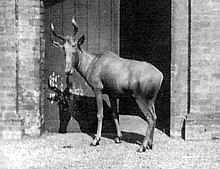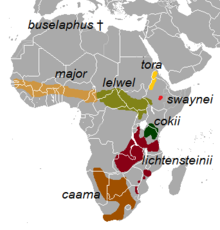Bubal hartebeest
| Bubal hartebeest | |
|---|---|
 |
|
| A female hartebeest that lived in London Zoo from 4 October 1883 until 27 April 1897. Photographed by Lewis Medland in 1895. | |
| Scientific classification | |
| Kingdom: | Animalia |
| Phylum: | Chordata |
| Class: | Mammalia |
| Order: | Artiodactyla |
| Family: | Bovidae |
| Subfamily: | Alcelaphinae |
| Genus: | Alcelaphus |
| Species: | A. buselaphus |
| Subspecies: | †A. b. buselaphus |
| Trinomial name | |
|
Alcelaphus buselaphus buselaphus (Pallas, 1766) |
|
 |
|
| A. b. buselaphus ranged north of the Sahara, from Morocco to Egypt | |
The bubal hartebeest, also known as bubal antelope or simply bubal (Alcelaphus buselaphus buselaphus) is the extinct nominal (i.e., first described) subspecies of hartebeest, that was formerly found north of the Saharan Desert. Other subspecies live currently in grasslands south of the Sahara, from Senegal in the west to Eritrea and Ethiopia in the east and down to middle Tanzania. The red hartebeest and Lichtenstein's hartebeest, alternatively considered subspecies or sister species of the common hartebeest, are present in southern Africa.
The bubal hartebeest was described as uniformly sandy colored, save for "an ill-defined patch of greyish on each side of the muzzle above the nostrils" and the terminal tuft of the tail, which was black. In this case the subspecies was similar to the plain colored Lelwel hartebeest, lacking white or black facial markings such as those present in the western hartebeest and Swayne's hartebeest. It measured 43 inches at the shoulder and the horns were 'U' shaped when seen from the front.
Like other hartebeests, the bubal was a social animal. Luis del Mármol Carvajal wrote that herds of 100 to 200 animals could be seen in northern Morocco in 1573. According to 19th century writers, the bubal hartebeest preferred rocky areas with a fair amount of vegetation, in contrast to the sandy and drier habitat of the Addax. Its main predator was the also extinct Barbary lion.
...
Wikipedia

